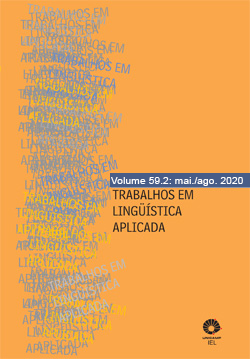Abstract
In this work, I present and discuss transculturalism, images and translation in Craig Thompson's graphic novel Habibi, trying to show how this work is a transcultural translation, since it aims to represent an Eastern Arab world to Western eyes, but incurring the same institutionalized orientalism that embodies several other works of art, science and politics in the Western world, which tend to diminish and homogenize the diverse cultures of the peoples living in what is now called the Middle East. In Habibi's case, it is through bodies and scenes that orientalism is most present, evoking the old formula of the Arabian Nights while telling its story - as if all the peoples of the Middle East lived in the desert wearing turbans, among other stereotypes. In the end, I present a possibility of translation through the images of the graphic novel, in order to try to diminish, at least a little, the influence of the biased orientalism in Habibi.
References
BAUMAN, Zygmunt. (1998). O mal-estar da pós-modernidade. Tradução de Mauro Gama e Cláudia Martinelli Gama. Rio de Janeiro: Jorge Zahar Editor.
BESANÇON, Alain. (1997). A imagem proibida: uma história intelectual da iconoclastia. Tradução de Carlos Sussekind. Rio de Janeiro: Bertand Brasil.
BLOMMAERT, Jan; VERSCHUEREN, Jef. (2002). Homogeneism. In: Debating Diversity: analysing the discourse of tolerance. New York: Routledge.
BURKE, Peter. (2004). Estereótipos dos outros. In: Testemunha ocular: história e imagem. Tradução de Vera M. X. dos Santos. Bauru, SP: EDUSC, p. 153-174.
CAMPOS, Rogério de. (2015). Imageria: o nascimento das histórias em quadrinhos. São Paulo: Veneta.
CHESTERMAN, Andrew. (2001). Proposal for a Hieronymic Oath. The Translator, v. 7, n. 2, p. 139-154.
COHN, Neil. (2013) The visual language of comics: Introduction to the structure and cognition of sequencial images. London: Bloomsbury.
DAMLUJI, Nadim. (2020). Can the Subaltern Draw? The Spectre of Orientalism in Craig Thompson’s Habibi. The Hooded Utilitarian. 05/10/2011. Disponível em https://www. hoodedutilitarian.com/2011/10/can-the-subaltern-draw-the-spectre-of-orientalism-in-craig-thompsons-habibi/ Acesso em 05/06/2020.
LAPLANTINE, François; NOUSS, Alexis. (1997). Le métissage – un exposé pour comprendre, um essai pour réfléchir. Paris: Flammarion.
LAPLANTINE, François. (2005). Le social et le sensible - Introduction à une anthropologie modale. Paris: Téraèdre.
LATOUR, Bruno. (2002). What is iconoclash? Or is there a world beyond the image wars? In Latour, B; Weibel, P. (eds). Iconoclash – Beyond the image wars in science, religion and art. Karlsruhe, Germany: ZKM, p. 15-38.
MALUF, Sonia W. (2001). Corpo e corporalidade nas culturas contemporâneas: abordagens antropológicas. Esboços, v. 9, n. 9, Florianópolis, p. 87-101. Disponível em: http://portfolio.unisinos.br/OA12/pdf/sonia_maluf_artigo.pdf Acesso em 05/06/2020
NASH, Kieran. (2017). The difference between an expat and a immigrant? Semantics. BBC: Worklife. Disponível em https://www.bbc.com/worklife/article/20170119-who-should-be-called-an-expat Acesso em 05/06/2020.
NOUSS, Alexis. (2012). A tradução: no limiar. Tradução de Izabela Leal. Alea: Estudos Neolatinos. 14:1, Rio de Janeiro. p. 13-34, jan/jun 2012. Disponível em: http://dx.doi.org/10.1590/S1517-106X2012000100002. Acesso em 21/02/2017
SACCO, Joe. (2003). Palestine. Seattle: Fantagraphics Books.
SAID. Edward. (2003a). Reflexões sobre o exílio. In Reflexões sobre o exílio e outros ensaios. Tradução de Pedro M. Soares. São Paulo: Cia das Letras. p. 46-60.
SAID. Edward. (2003b). Orientalism. London: Penguin Books.
THOMPSON, Craig. (2011a). Habibi. New York: Pantheon.
THOMPSON, Craig. (2011b). Craig Thompson: fundamentals. [Entrevista concedida a] Meakin Armstrong. Guernica. 15/09/2011. Disponível em https://www.guernicamag.com/thompson_interview_ 9_15_11/ Acesso em 05/06/2020.
THOMPSON, Craig. (2011c). A Conversation about Habibi’s Orientalism with Craig Thompson. [Entrevista concedida a] Nadim Damluji. The Hooded Utilitarian. 16/11/2011. Disponível em https://www.hoodedutilitarian.com/ 2011/11/a-conversation-about-habibis-orientalism-with-craig-thompson/ Acesso em 05/06/2020.
THOMPSON, Craig. (2012). Habibi. Tradução Érico Assis. São Paulo. Quadrinhos na Cia.
TOLEDO, Leonardo. (2015). A formação da identidade transcultural, a exemplo de Rafik Schami. Mutatis Mutandis – Traducción, género e identidad, v. 8, n. 2, p. 466-484.
TRADURRE. (2008). Direção de Pier Paolo Glarolo. Itália: Jolefilm. Disponível em https://www.youtube.com/watch?v=JCLoKrZbkxk Acesso em 05/06/2020.
YUSTE FRÍAS, José. (2011). Leer e interpretar la imagen para traducir. Trab. Ling. Aplic, v. 50, n. 2, Campinas, p. 257-280.
YUSTE FRÍAS, José. (2013). Nuevas perspectivas para traducir la imagen em publicidade internacional. In DOMÍNGUEZ. Xoán M (ed). In Traducción para la comunicacion internacional. Granada: Editorial Comares, p. 83-92.
WELSCH, Wolfgang. (2010). Was ist eigentlich Transkulturalität? In Darowska, L.; Lüttenberg, T.; Machold, C. (eds). Hochschule als transkultureller Raum? Beiträge zur Kultur, Bildung und Differenz. Bielefeld, Deutshland: Transcript, p. 39-66.
O periódico Trabalhos em Linguística Aplicada utiliza a licença do Creative Commons (CC), preservando assim, a integridade dos artigos em ambiente de acesso aberto, em que:
- A publicação se reserva o direito de efetuar, nos originais, alterações de ordem normativa, ortográfica e gramatical, com vistas a manter o padrão culto da língua, respeitando, porém, o estilo dos autores;
- Os originais não serão devolvidos aos autores;
- Os autores mantêm os direitos totais sobre seus trabalhos publicados na Trabalhos de Linguística Aplicada, ficando sua reimpressão total ou parcial, depósito ou republicação sujeita à indicação de primeira publicação na revista, por meio da licença CC-BY;
- Deve ser consignada a fonte de publicação original;
- As opiniões emitidas pelos autores dos artigos são de sua exclusiva responsabilidade.


